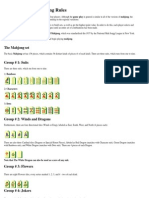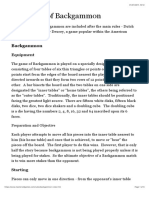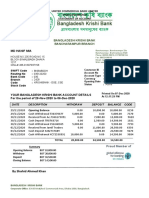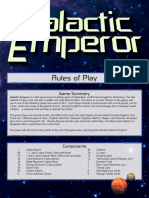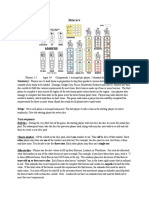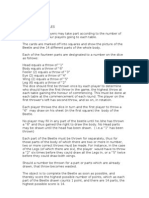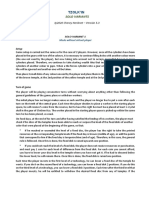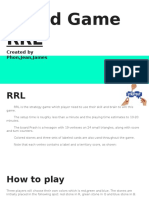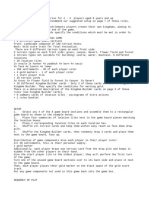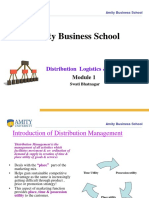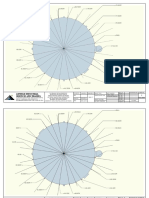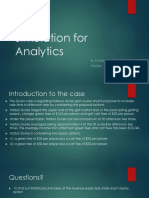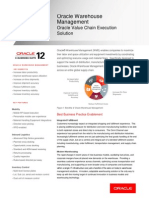Nauticus Rules (English Translation)
Nauticus Rules (English Translation)
Uploaded by
jeremyheilmanCopyright:
Available Formats
Nauticus Rules (English Translation)
Nauticus Rules (English Translation)
Uploaded by
jeremyheilmanCopyright
Available Formats
Share this document
Did you find this document useful?
Is this content inappropriate?
Copyright:
Available Formats
Nauticus Rules (English Translation)
Nauticus Rules (English Translation)
Uploaded by
jeremyheilmanCopyright:
Available Formats
Overview
Players assume the roles of entrepreneurs who are engaged in the fields of shipbuilding, trade and transport. So, you are shipyard owner, merchant
and shipowner all in one. As a shipyard owner, you build player ships of various sizes. As a merchant, you purchase goods that need to be transported
on the completed ships, by the shipowners. There are victory points for both shipped goods and for ships themselves. The player with the most
victory points after 5 rounds (or 4 for a two player game) is the winner.
Game Board Layout
The game board is placed in the middle of the table.
Bonus Area for
each player
action
Costs for
each action
Round Track
(place Round
Marker here)
Scoring Track
Place Turntable in the
middle of the board
on the Action Wheel
The Action Tiles are placed
in these fields
Starting Space for
Victory Point
Markers
4 Player
Warehouse
Boards
1 Turntable
1 Score Overview Tile
(Victory Points at
end of game)
8 Action Tiles
1 Anchor Tile
18 Single-Vessel Tiles
18 Bow Tiles
18 Stern Tiles 9 Center Hull
Tiles
72 Masts (4 x 15 Masts with 4 different
coats of arms + 12 Masts with Crown
72 Sails (4 x 15 Sails
with 4 different
coats of arms
+ 12 Sails
with Crown
48 Goods Tiles
(12 each of Fish,
Coffee, Grain
and Salt)
42 Coins (26 x 1Taler, 16 x 5 Taler)
12 Pass Tiles (4 sets with
-3, -2, -1 VPs)
4 Extra Action
Tiles
1 Game Board
28 Worker
Cubes
4 Victory Point
Markers in player
colors
Game Components
1 Start Player
Marker
1 Round
Marker
The following materials are placed on the board:
- The Turntable is placed in the middle of the board. At the start of the
game align the section with the Anchor to the Bonus space showing
3 Workers, as shown.
The Round Marker is placed on space 1 of the Round Track.
Each player puts their Victory Point Marker on space 10 of the
Scoring Track.
-
-
The remaining game materials are sorted as follows:
-
-
-
-
-
The Workers are placed next to the board as a general supply.
The Ship Tiles (Single-Vessel, Bow, Center Hull, Stern, Masts and Sails) are sorted by
type and placed in 14 face-up stacks next to the board. (It is advised to group together
the Masts, Sails and Hull Parts, and to separate the Sails and Masts with Crowns from
those without.)
The Goods Tiles are also sorted by type and placed in 4 face-up stacks next to the board.
The Taler Coins are placed next to the board as a general supply.
The 8 Action Tiles, the Anchor Tile and the Score Overview Tile are set aside for now.
Each player receives at the start of game:
- 1 Player Warehouse Board, which he puts on the table in front of him.
4 Workers from the general supply, which he sets beside his Warehouse as his personal
stock.
15 Taler Coins in any denomination, set alongside his Warehouse as his personal
stock.
1 Extra Action Tile
1 set of Pass Tiles (with -3, -2, -1 Victory Points), set with the number side up next to
the Warehouse. (It is best to stack the three tiles so that the tile with the -1 Victory Points
is at the bottom of the pile, with the -3 Victory Points tile is at the top.)
-
-
-
-
Notes on using the game materials
-
-
-
Number (and type) of all Workers and Coins in the personal stock, tiles in the
Warehouse, Goods already delivered and the status of the Pass Tiles and the possession of
the "Extra Action" Tile are fundamentally open information. The material must be kept
visible on the table and the exact number is available to the other players on demand.
Workers and Coins in the general supply are unlimited. In the unlikely event that there
are not sufficient Coins or Workers, replacements should be used.
The Ship Tiles and Goods are limited in number. If the stack of a certain type is depleted,
the player can no longer obtain them. Counting how many tiles of one type are still
available is always allowed.
The most inexperienced player is the starting player and receives the Starting Player Token.
The player in position 2 receives one additional Taler.
In the three player game, player 3 receives 2 additional Taler and 1 additional Worker.
In a four player game, player 3 receives 1 additional Taler and 1 additional Worker
and player 4 receives 2 additional Taler and 2 additional Workers.
Note: After completion of each action phase, the start player marker moves to the next
player clockwise.
The Game
Place Turntable in the middle of the board
and align Anchor space with 3 Workers
Bonus space.
Place Round Marker on space 1 of Round
Track.
Place each Player Marker on space 10 of
Scoring Track.
Put Workers as a supply next to game board.
Sort Ship Tiles by type in 14 stacks.
Sort Goods Tiles by type in 4 stacks.
Put Coins as a supply next to game board.
Each player receives:
1 Warehouse, 4 Workers, 15 Taler,
1 Extra Action tile, 1 set of Pass Tiles
All information on the ownership of
Workers, Coins, Tiles, etc., is basically
open.
Workers and Coins in the general
supply are unlimited.
Ship Tiles and Goods are limited to the
amount present.
The most inexperienced player is the
starting player.
Player 2 receives 1 additional Taler.
Player 3 receives 1 additional Worker
and 2 Taler in the three player game.
In the four player game, Player 3 receives
1 additional Worker and 1 Taler, and
Player 4 receives 2 additional Workers
and 2 Taler.
2
Game play (Overview)
The main focus in Nauticus is on the ships. Completed ships bring victory points at
game end and are essential to getting additional victory points for goods. Four different
ship sizes can be built (1, 2 , 3 or 4 tiles). Larger ships gain significantly more victory points
but are harder to build and and it takes more time until they can be used for the
transportation of goods, since each vessel must have matching masts and sails.
Nauticus is played in rounds. In a game with three or four players, 5 rounds are
played. In the two-player game only 4 rounds are played. Each round consists of exactly
7 action phases. The players decide what the action phases are, and in which order they are
executed. At the beginning of an action phase, the current first player chooses an action.
This action is then performed by him, then by the other players in clockwise order. Thus,
all players are constantly involved in the game. Once all players have made or passed the
current action, the starting player changes. The next player then selects the next action. At
the end of the round, a short intermediate phase takes place, in which the action wheel for
the next round is built, and negative points for remaining Pass Tiles are awarded. Then the
next round starts as before, until 4 or 5 rounds have been completed.
The Golden Rule
The Golden Rule in Nauticus is, without exception, as follows: whenever any player
receives a free tile (meaning that it was acquired without spending any Taler), this tile must
first be placed in that players Warehouse. (Since it is easy to forget this rule, you should
not miss the opportunity to stress this when explaining the game to other players.)
Preparation for a new Round
-
-
-
The Round Marker is advanced one position on the Round Track (not applicable to
the start of the game).
The Turntable is rotated so that the Anchor space aligns with the Action Tile on which
the Anchor Tile is located (not applicable to the start of the game).
Once the Turntable is realigned, the Anchor Tile is set aside. Then all 8 Action Tiles are
collected by the current start player, randomly shuffled, and dealt face up on the 8
action fields of the board, starting with the field that displays the Anchor space of the
Turntable. Make sure to place the Action Tiles such that the Bonus fields are visible!
Turn Sequence
A Round consists of 7 action phases. The first player starts the first action phase, by
selecting one of the 8 Action Tiles and performs the action. (Alternatively, he can pass
instead of performing the selected action.) Then the next player in clockwise order chooses
whether he wants to perform this same action or pass. This continues until all players have
had the opportunity to perform the action or pass. Then this action phase ends. The chosen
Action Tile is flipped over and is no longer available for the rest of the round. After the
first action phase of a round, the Anchor Tile is placed on the inverted Action Tile. The
Start Player Marker is passed to the next player in clockwise order. Now this player selects
from the remaining Action Tiles and decides whether he wants to carry out the action or
pass. Once all the players have acted on this action, the Action Tile is flipped over and the
Start Player Marker is passed clockwise again. This is repeated until seven of the eight
Action Tiles have been selected and performed. After the seventh round is complete, the
remaining eighth action is not performed in this round.
4 sizes of ships may be built: 1, 2, 3
and 4-tile.
Only 1 type mast/sail per ship.
Two-player game: 4 rounds
Three and four players: 5 rounds
Each round consists of 7 action phases.
Starting player chooses an action, executes
it, then every other player perform the same
action. The start player then changes.
End of the round: determine actions for
next round, negative points awarded
according to remaining Pass Tiles.
Golden Rule
When you get a free tile (without paying
money), it must be placed in your
Warehouse first.
Preparing new Round
Round Marker advances.
Rotate Turntable to align the Anchor space
on it with the Anchor Tile marker from the
previous round.
Set the Anchor Tile aside, shuffle Action
Tiles and place randomly on board, starting
at Anchor space on Turntable.
Turn Sequence
Round = 7 action phases
First player: Select any action, take that
action or pass.
All other players in clockwise direction:
Perform action or pass.
End of action phase: Flip Action Tile,
place Anchor Tile (first phase only),
pass Start Player Marker, new starting
player chooses the next action, etc.
End of Round: After 7 action phases.
8th Action Tile is not activated.
3
Performing an action
1. Bonus
The player who selects the action gets the bonus printed on the Turntable which is
associated with the selected Action Tile. The player gets this bonus regardless of whether he
performs the selected action or passes. When the player gets the bonus, he pushes the
Action Tile down so that the bonus space is covered. Then he decides whether he wants to
perform the action (e.g. buy hull parts, as shown below) or not.
Important: Only the player that chooses the action receives the bonus. All other players
can only perform the selected action or pass.
These are the bonuses (starting with the 3 Workers, clockwise in the order in which
they are printed on the schedule in the center of the board):
-
-
-
-
-
-
-
-
3 Workers (with beige clothes): The starting player receives 3 Workers from the
general supply and places them in his personal stock.
Mast: The starting player receives one free regular Mast tile of his choice and puts it
into his Warehouse (no Masts with Crowns). (Do you remember the Golden Rule?)
Sail: The starting player receives one free regular Sail tile of his choice and puts it
into his Warehouse (no Sails with Crowns).
2 Victory Points: The starting player receives 2 Victory Points and moves his Victory
Point Marker on the Scoring Track accordingly.
2 Workers (with beige clothes): The starting player receives 2 Workers from the
general supply and places them in his personal stock.
1 Worker (with beige clothes) + 1 Goods: The starting player receives one Worker
from the general supply and places it in his personal stock. Furthermore, he receives
one Goods of any kind, which he puts into his Warehouse.
1 Worker (with beige clothes) + 1 Victory Point: The starting player receives 1
Worker from the general supply and places it in his personal stock. He also receives
1 Victory Point and moves his Victory Point Marker on the Scoring Track accordingly.
4 Taler: The starting player gets 4 Taler from the general supply.
2. Blue Workers on the Turntable
On the Turntable, Workers with blue clothes are shown. Each field, except for the Anchor
field, shows 1, 2 or 3 Workers. When an action is chosen, these are the Workers who are
assigned to the selected action, and all players that perform this action can utilize those
Workers.
Important: Unlike the workers with beige clothes (on the Bonus spaces), you will not get
these Workers in the form of actual cubes from the general supply. These 1, 2 or 3 Workers
are virtual Workers, and are only available for performing the selected action. If a player
does not use all the Workers, he forfeits any left over and/or unused.
Performing an action
Bonus
The starting player receives the printed
bonus of the selected action - regardless of
whether he passes or performs the action.
All other players will not get the bonus of
this action.
Bonuses
3 Workers: Player receives 3 Workers.
Mast/Sail: Player receives Mast or Sail
tile (regular Mast/Sail only, not the Crown
mast/sail).
2 Victory Points: Player receives 2
Victory Points.
2 Workers: Player receives 2 workers.
1 Worker + 1 Goods: Player receives
1 Worker and 1 Goods.
1 Worker + 1 Victory Point: Player
receives 1 Worker and 1 Victory Point.
4 Taler: Player gets 4 Taler.
Blue Workers on the Turntable
These Workers are available to any player
who chooses this action. They are
obtained, not as actual cubes, but only
virtually, meaning you can only use them
for the current action.
Example: Player A is the starting player and chooses the action buy hulls. He gets the printed bonus which this action is assigned to
(2 VPs). Then he pushes the action tiles down so that the bonus space is covered.
4
3. The Actions
3.1 General Action
-
-
-
-
-
-
-
When an action is selected, the first player acts upon it, then in clockwise order, the
remaining players act on the same action. Performing an action is not mandatory.
Alternatively, a player can pass (even the starting player may choose an action and
then pass). If a player passes, he flips one of his 3 Pass Tiles to the Crown side. It is
advisable in this case to flip the -3 Tile first, then the -2 Tile and finally the -1 Tile.
(The reverse side shows a Crown whose meaning is explained in 3.2.2.4 Evaluation
of the Crown.)
Each of the 8 actions can be used multiple times by the players in an action phase.
However, one Worker is needed for every use of the action. One can (and will) use
the blue Workers shown on the Turntable to perform the action. If you want to use an
action more times than the blue Workers that are available, you must take a corresponding
number of Workers from your personal stock and return them to the general supply.
4 of the Action Tiles have a blue background, the other 4 have a beige background.
The numbers 0, 1, 2, and 3, which are printed on the board next to the storage areas for
Action Tiles, are only of importance for the blue Action Tiles. With the blue actions,
you buy ship parts or Goods. This costs not only Workers, but also Taler. The price of a
particular ship part/Goods depends on the number that is shown next to the relevant part
of the ship/Goods on the Action Tile. For beige Actions there are no Taler costs,
therefore the 0, 1, 2, and 3 for these actions are disregarded.
The listed prices (0, 1, 2, or 3) are for the first purchase of each of the various Tiles.
To buy more than one of a particular Tile/Goods, the additional Tiles/Goods cost
4 Taler (and 1 Worker) each, regardless of the listed price of this Tile/Goods.
If a player buys all 4 different ship parts/Goods shown on an Action Tile, he will
receive one additional Tile/Goods of the type available on the Action Tile (without the
need for using a Worker) .
Reminder: All Tiles obtained free of charge must be placed in the Warehouse. Workers
are not considered as costs; therefore, a Tile that you can buy for 0 coins is considered
free even when you use a Worker to buy it, and must be placed in the Warehouse.
It follows, then, that all tiles for which one has paid at least one Taler can be used
immediate, without needed to go through the Warehouse. (Also see the explanation of
each individual action.)
Actions
Actions need not be performed.
Passing players flip one of their Pass Tiles
to the Crown side.
Actions can be taken by a player several
times. Each use costs 1 Worker. If you use
all the printed blue Workers, you have to
additionally make use of Workers from
your own stock.
Blue Action Tiles cost extra Taler. The exact
costs are determined by the numbers 0-3
printed on the board.
Beige Action Tiles do not cost Taler, the
numbers are disregarded for those tiles.
Listed prices are for first purchase only.
The price of additional Tiles/Goods of the
same type is always another 4 Taler.
The purchase of all 4 different ship parts/
Goods gives another Tile/Goods of the type
purchased.
Free ship parts/Goods are stored in the
Warehouse.
Ship parts/Goods that are paid for can be
used immediately.
Example: The first player chooses the action buy hull parts. He receives
a bonus of 2 Victory Points and pushes the Action Tile down to cover the
bonus space. Then he performs the action buy hull parts. He buys all
4 hull parts on the Action Tile, and therefore has to pay 6 Taler and employ
4 Workers. 2 blue Workers are available to him from the Turntable, so he
still needs 2 Workers from his personal stock, so he puts them back in the
general supply. Because he bought all 4 parts on the Action Tile, he gets a
free hull part of hischoice, which he puts into his Warehouse. Then it is the
5
next players turn. He buys a bow and a stern and pays 1 + 3 = 4 Taler for it. As it uses the 2 available blue Workers, he need not employ
any Workers from his stock. The third player buys a 0-cost Single Vessel Tile and puts it into his Warehouse. He does not need to pay
any Talers and does not use Workers from his personal stock, because 2 blue Workers for the action are available. But since it requires
only one Worker,the unused Workers are disregarded.
1 2 3 0
3.2 The individual actions
3.2.1 Paid actions (blue Action Tiles)
The printed numbers 03 next to the Action Tiles are of importance only for the paid actions
(blue Action Tiles). The numbers are the prices for the corresponding Tiles shown below them.
Paid means that every action performed costs 04 Thaler in addition to the standard 1 Worker.
3.2.1.1 Buy Hull Parts
The hull (body) parts are the basis of all ships. Without masts,
sails and goods, they can not be used effectively.
In Nauticus, 4 different sizes of ships can be built. For
the 1-Tile ship there is a separate, Single-Vessel Tile. The larger
vessels consist of a Bow Tile, a Stern Tile, and 0, 1 or 2 Center
Hull Tiles.
When Hull Tiles are purchased, any free tiles must be placed in the Warehouse (Golden
Rule), and the remaining Tiles may be placed directly in front of him in his shipyard.
Once a player has put together a Bow and Stern to start a 2-Tile ship, it is not possible to
then insert a midsection (Center Hull Tile). 3- and 4-Tile ships may be built by starting from
one side only, or by starting in the middle. Therefore, you can not leave a gap between a
Bow and a Stern with 1 or 2 parts in order to build a 3- or 4-Tile ship there later. If you put a
Bow and a Stern separately from each other in the shipyard, you have two ships under
construction, not one. It is not possible to combine these in the same vessel later.
Note: The hull of a ship need not be finished in one action. It is possible (and in large ships
often the case) that there are several Buy hull parts actions required to complete a hull.
The individual actions
Paid actions
Cost per use is 04 Taler plus 1 Worker.
Buy Hull Parts
There are 1-Tile ships, Bows, Stern and
Center Hull Tiles.
The Single-Vessel Tile is for a 1-Tile ship.
Bows, Stern and Center Hull Tiles can be
combined for 2-, 3- and 4-Tile ships.
Hull parts that you do not have to put
the Warehouse can be placed directly on
the table (in the shipyard).
All pieces that are placed in the shipyard
cannot be moved or replaced later.
A ship whose size is fixed by placing a
Bow and a Stern can no longer be
reduced or expanded.
Example:
Player A buys all 4 parts on the Buy hull parts Action Tile with
4 workers and 6 Taler. He gets an additional hull part free as a bonus.
He chooses another Single-Vessel Tile as his bonus Tile. Both Single-
Vessel Tiles he must put into his Warehouse since he received
them for free. He builds a 2-Tile ship with the Bow and Stern Tiles. He
sets aside the Center Hull Tile to start another ship. He will later
add more hull parts and build a 3-or 4-Tile ship.
Action Tile Buy Hull Parts
1-Tile ship 4-Tile ship
2-Tile ship 3-Tile ship
6
1 2 3 0
3.2 The individual actions
3.2.1 Paid actions (blue Action Tiles)
The printed numbers 03 next to the Action Tiles are of importance only for the paid actions
(blue Action Tiles). The numbers are the prices for the corresponding Tiles shown below them.
Paid means that every action performed costs 04 Thaler in addition to the standard 1 Worker.
3.2.1.1 Buy Hull Parts
The hull (body) parts are the basis of all ships. Without masts,
sails and goods, they can not be used effectively.
In Nauticus, 4 different sizes of ships can be built. For
the 1-Tile ship there is a separate, Single-Vessel Tile. The larger
vessels consist of a Bow Tile, a Stern Tile, and 0, 1 or 2 Center
Hull Tiles.
When Hull Tiles are purchased, any free tiles must be placed in the Warehouse (Golden
Rule), and the remaining Tiles may be placed directly in front of him in his shipyard.
Once a player has put together a Bow and Stern to start a 2-Tile ship, it is not possible to
then insert a midsection (Center Hull Tile). 3- and 4-Tile ships may be built by starting from
one side only, or by starting in the middle. Therefore, you can not leave a gap between a
Bow and a Stern with 1 or 2 parts in order to build a 3- or 4-Tile ship there later. If you put a
Bow and a Stern separately from each other in the shipyard, you have two ships under
construction, not one. It is not possible to combine these in the same vessel later.
Note: The hull of a ship need not be finished in one action. It is possible (and in large ships
often the case) that there are several Buy hull parts actions required to complete a hull.
The individual actions
Paid actions
Cost per use is 04 Taler plus 1 Worker.
Buy Hull Parts
There are 1-Tile ships, Bows, Stern and
Center Hull Tiles.
The Single-Vessel Tile is for a 1-Tile ship.
Bows, Stern and Center Hull Tiles can be
combined for 2-, 3- and 4-Tile ships.
Hull parts that you do not have to put
the Warehouse can be placed directly on
the table (in the shipyard).
All pieces that are placed in the shipyard
cannot be moved or replaced later.
A ship whose size is fixed by placing a
Bow and a Stern can no longer be
reduced or expanded.
Example:
Player A buys all 4 parts on the Buy hull parts Action Tile with
4 workers and 6 Taler. He gets an additional hull part free as a bonus.
He chooses another Single-Vessel Tile as his bonus Tile. Both Single-
Vessel Tiles he must put into his Warehouse since he received
them for free. He builds a 2-Tile ship with the Bow and Stern Tiles. He
sets aside the Center Hull Tile to start another ship. He will later
add more hull parts and build a 3-or 4-Tile ship.
Action Tile Buy Hull Parts
1-Tile ship 4-Tile ship
2-Tile ship 3-Tile ship
6
2 1 0 3
3.2.1.2 Buy Mast
There are 5 types of masts, distinguished by the emblems on the flags. Only 4 of these
mast types can be bought using this action. The Crown masts can not be bought, they can
only be received as a reward for completed ships (see page 10, 4 Rewards for Completed
Ships). Purchased (paid) masts can be built immediately on previously purchased ship
hulls. It does not matter if the hull has been completed or not. However, a ship can only
contain one type of mast (mixing different mast types is not allowed). Exception: The
Crown mast is wild and can be combined with any other mast. Purchased masts that
can not be put directly on hulls must be placed in the Warehouse along with any free masts
and any masts that the player chooses not to place.
Example:
Player A buys 1 green/red Whale
mast for 0 Taler and 2 light green
Anchor masts, the first for 1 Taler,
and the second for 4 Taler. He needs
to use 3 Workers as well. He must
store the Whale mast in his
Warehouse, but the 2 Anchor
masts can be built immediately.
Buy Mast
Only the 4 regular masts can be purchased,
not the Crown mast.
Crown masts are received as a reward for
completed ships.
Paid masts can be built directly on hulls
already in the shipyard, whether the hull
is already complete or not.
On every ship, only one type of mast may
be used. (Excluding the Crown masts, which
are wild and may be used anywhere.)
Buy Sail
Only the 4 regular sails can be purchased,
not the Crown sail.
Crown sails are received as a reward for
completed ships.
Paid sails can be placed directly on
supporting masts of the same type in the
shipyard. Every ship may only use one
type of mass and sail. (Exception: Crown
masts and sails, which are wild and may
be used anywhere.)
Incorrectly built ship, since two different types of sails were
used. Although the yellow/brown Wheel sail is located on a
Crown mast, due to the earlier placement of the light green
Anchor mast and sail on the Stern, the ships coat of arms
is now set to Anchor.
Correctly built ship with Crown mast and sail
3.2.1.3 Buy Sail
Correctly built ship
7
Action Tile Buy Mast
There are 5 types of sails, distinguished by the emblems on them.
Only 4 of these sail types can be purchased via this action. The
Crown sails can not be bought, they can only be received as a
reward for completed ships (see page 10, 4 Rewards for Completed
Ships). Purchased (paid) sails can be immediately placed on masts
with the same coat of arms as the sail. Exception: Crown sail is wild
and can be placed on masts of any kind, and any sail can be placed on a
Crown mast. Purchased sails that
can not be put directly on masts
must be placed in the Warehouse
along with any free sails and any
sails that the player chooses not
to place.
0 1 2 3
3.2.1.4 Buy Goods
The purchase of Goods works the same as the purchase of ship
parts. Purchased (paid) Goods can be placed under the hull parts in
the shipyard, including unfinished ships. Each hull part has space
for exactly one Goods Tile, which is placed directly under the hull
part. The Goods loaded on a ship do not have to match. Goods that
have been loaded into a ship cannot be transferred to other ships,
they can be shipped only with the Action Deliver Goods (see page 9,
3.2.2.3 Deliver Goods).
Buy Goods
Purchased Goods can be placed directly
under the hull parts in the shipyard.
Each hull part can be assigned exactly
one Goods, whether the ship is
completed or not.
A ship can transport any types of Goods,
they do not have to match.
Goods can not be moved. They leave
the ship only through the action
Deliver Goods.
3.2.2 Free actions (beige Action Tiles)
When taking any of the 4 free actions, the printed numbers 03 next to the beige Action Tile
are disregarded. "Free" means that these actions do not to be paid for with Taler, but they
still require one Worker for each action taken.
3.2.2.1 Transport (from Warehouse to Shipyard)
In their Warehouses, players collect all ship parts and Goods they
have received either for free, or that they have chosen not to add
to a ship under construction. Each Hull part, Sail and Goods takes
exactly 1 Warehouse space to store. Masts take 2 spaces to store. You
can rearrange the Warehouse as you wish (if you want, for example,
to store a Mast, but there are not 2 spaces next to each other). However,
if all 12 spaces in the Warehouse are full, no further ship parts or products can be stored.
With the Transport action, a player moves ship parts and Goods to the shipyard. You can
move any number of Tiles to the shipyard with this action, but one Worker is needed for
each transported Tile. The Tiles can be added to existing ships or can create new ones.
3.2.2.2 Withdraw money
With this action, take money from the general supply. For each
Worker a player uses, he receives 2 Taler from the general supply.
Free actions
These require no Taler, but the use of
one Worker per action is still needed.
Transport from Warehouse to
Shipyard
Each Warehouse has 12 spaces. Each Tile
requires 1 storage space, and Masts need 2.
One can rearrange his Warehouse at
any time. If the Warehouse is full,
nothing more can be stored.
With this action, Tiles are moved from
the Warehouse to the shipyard (ships
built and Goods loaded). For each Tile
which is moved from the Warehouse
to the shipyard, one Worker is needed.
Withdraw money
For each Worker used, take 2 Taler
from the general supply.
Example:
Player A buys four Goods: 1 fish, 1 grain and 2 coffee. The second coffee costs him 4 Taler. He needs 4 workers and 7 Taler. He places
1 coffee and the grain directly under two hulls in the shipyard. The free coffee and the fish he puts into his Warehouse, although he could
also put the fish on the available hull. Under certain circumstances it could be useful for Player A to buy, instead of the second coffee for 4
Taler, the salt for 3 Taler and then get an extra coffee as a bonus for purchasing all four types of Goods. This would have saved him 1 Taler
but then he would have to put both coffee tiles into his Warehouse, since they were both free.
Action Tile Buy Goods
8
3.2.2.3 Deliver Goods
This action can only be performed by players who have at least 1
fully finished ship (Hull + Mast[s] + Sail[s]) which is fully loaded
with Goods, i.e. there is a Goods Tile under each hull section. If one
chooses to deliver Goods, he can deliver any number of fully loaded
ships, but he must always deliver the entire cargo of a ship. For each
Goods to be delivered, 1 Worker is required. Partial deliveries are not
possible. Thus, if the player cannot deliver all the Goods of a large ship because he does not
have enough Workers available, he may not deliver any Goods from that ship. Delivered Goods
are collected to the right of the Warehouse, sorted by type. These Goods bring the player
Victory Points at the end of the game; the more Goods of a single type delivered, the more
Vicotory Points earned (see page 11, Victory Points for delivered Goods ). Once a ship has
been emptied of its delivered Goods, it may be loaded again with Goods for further deliveries.
3.2.2.4 Evaluation of the Crowns
By taking this action you can obtain Victory Points based on the
number of currently visible Crowns. A player using this action
counts all of his visible Crowns. This includes Crowns on the Crown
Masts and Crown Sails (it does not matter whether they are part of a
built ship or still in the Warehouse, any Crowns in a players possession
count). Also, there are Crowns on the back of the Pass Tiles. The sum of all Crowns on Masts,
Sails, and inverted (used) Pass Tiles results in the number of Victory Points the player receives
per Worker used, and he advances his marker on the Victory Point track. Important: A player
can receive a maximum of 15 Victory Points per round using this action. Exception: if the
Extra action Tile (see page 10, 5 Extra Action Tile) is used, a player can once again
(within the same Round) receive Victory Points on the evaluation of the Crowns, thus it is
theoretically possible to receive up to a maximum of 30 Victory Points in the same Round once
per game.
Deliver Goods
Only possible when at least one finished
ship is fully loaded with Goods. The total
cargo of a ship must be delivered. 1 Worker
is required for each Goods delivered.
Delivered Goods are collected to the right
of the Warehouse. Victory Points are earned
at game end, depending on the number of
Goods of each type delivered. Emptied
ships can be loaded again.
Evaluation of the Crowns
For each Worker used, earn as many Victory
Points as visible Crowns currently owned.
Crowns appear on Crown Casts and Crown
Sails , and on the back of the Pass Tiles.
You can receive a maximum of 15 Victory
Points per round by using this action.
(Exception: the Extra Action Tile.)
Example: Player B has 1 Crown Mast on a built ship and 1 Crown Sail in his Warehouse. In addition, he has 1 inverted (used) Pass Tile.
He uses the 2 blue Workers who are currently assigned to this action, and 1 Worker from his personal stock. He receives 3 x 3 = 9 Victory
Points and moves his Vicory Point Marker on the Scoring Track. If he had used 2 additional Workers, he would have received the maximum
amount of 15 Victory Points.
3.3 Passing
A player may choose not to perform an action, but pass instead. This is not necessarily a
bad thing, for every time a player passes, he may turn one of his Pass Tiles over to reveal
a Crown. At the end of the Round each player loses Victory Points according to his unused
(unflipped) Pass Tiles. A player who does not pass at all in a Round, loses a total of
6 Victory Points. By passing just once, he has already reduced this loss to 3 Victory Points.
Therefore, it is often useful to pass at least once per Round. In addition, flipping over a
Pass Tile reveals 1 additional Crown that can earn additional Victory Points if the action
Evaluation of the Crowns is taken anytime during the remainder of the current Round.
Reminder: The start player for the current action phase may select an Action Tile and still
pass. He will not be able to take the action, but he still receives the bonus for the selection
of the action.
Passing
Any player not performing an action flips
over 1 Pass Tile. At the end of each Round
Victory Points are lost for Pass Tiles which
have not been flipped.
Each flipped Pass Tile provides 1 Crown
for the Crown evaluation action.
The starting player gets the bonus of the
selected action even if he passes on the
action itself.
9
max 15
3.2.2.3 Deliver Goods
This action can only be performed by players who have at least 1
fully finished ship (Hull + Mast[s] + Sail[s]) which is fully loaded
with Goods, i.e. there is a Goods Tile under each hull section. If one
chooses to deliver Goods, he can deliver any number of fully loaded
ships, but he must always deliver the entire cargo of a ship. For each
Goods to be delivered, 1 Worker is required. Partial deliveries are not
possible. Thus, if the player cannot deliver all the Goods of a large ship because he does not
have enough Workers available, he may not deliver any Goods from that ship. Delivered Goods
are collected to the right of the Warehouse, sorted by type. These Goods bring the player
Victory Points at the end of the game; the more Goods of a single type delivered, the more
Vicotory Points earned (see page 11, Victory Points for delivered Goods ). Once a ship has
been emptied of its delivered Goods, it may be loaded again with Goods for further deliveries.
3.2.2.4 Evaluation of the Crowns
By taking this action you can obtain Victory Points based on the
number of currently visible Crowns. A player using this action
counts all of his visible Crowns. This includes Crowns on the Crown
Masts and Crown Sails (it does not matter whether they are part of a
built ship or still in the Warehouse, any Crowns in a players possession
count). Also, there are Crowns on the back of the Pass Tiles. The sum of all Crowns on Masts,
Sails, and inverted (used) Pass Tiles results in the number of Victory Points the player receives
per Worker used, and he advances his marker on the Victory Point track. Important: A player
can receive a maximum of 15 Victory Points per round using this action. Exception: if the
Extra action Tile (see page 10, 5 Extra Action Tile) is used, a player can once again
(within the same Round) receive Victory Points on the evaluation of the Crowns, thus it is
theoretically possible to receive up to a maximum of 30 Victory Points in the same Round once
per game.
Deliver Goods
Only possible when at least one finished
ship is fully loaded with Goods. The total
cargo of a ship must be delivered. 1 Worker
is required for each Goods delivered.
Delivered Goods are collected to the right
of the Warehouse. Victory Points are earned
at game end, depending on the number of
Goods of each type delivered. Emptied
ships can be loaded again.
Evaluation of the Crowns
For each Worker used, earn as many Victory
Points as visible Crowns currently owned.
Crowns appear on Crown Casts and Crown
Sails , and on the back of the Pass Tiles.
You can receive a maximum of 15 Victory
Points per round by using this action.
(Exception: the Extra Action Tile.)
Example: Player B has 1 Crown Mast on a built ship and 1 Crown Sail in his Warehouse. In addition, he has 1 inverted (used) Pass Tile.
He uses the 2 blue Workers who are currently assigned to this action, and 1 Worker from his personal stock. He receives 3 x 3 = 9 Victory
Points and moves his Vicory Point Marker on the Scoring Track. If he had used 2 additional Workers, he would have received the maximum
amount of 15 Victory Points.
3.3 Passing
A player may choose not to perform an action, but pass instead. This is not necessarily a
bad thing, for every time a player passes, he may turn one of his Pass Tiles over to reveal
a Crown. At the end of the Round each player loses Victory Points according to his unused
(unflipped) Pass Tiles. A player who does not pass at all in a Round, loses a total of
6 Victory Points. By passing just once, he has already reduced this loss to 3 Victory Points.
Therefore, it is often useful to pass at least once per Round. In addition, flipping over a
Pass Tile reveals 1 additional Crown that can earn additional Victory Points if the action
Evaluation of the Crowns is taken anytime during the remainder of the current Round.
Reminder: The start player for the current action phase may select an Action Tile and still
pass. He will not be able to take the action, but he still receives the bonus for the selection
of the action.
Passing
Any player not performing an action flips
over 1 Pass Tile. At the end of each Round
Victory Points are lost for Pass Tiles which
have not been flipped.
Each flipped Pass Tile provides 1 Crown
for the Crown evaluation action.
The starting player gets the bonus of the
selected action even if he passes on the
action itself.
9
max 15
4. Rewards for completed ships
Each time a player completes a ship, he briefly interrupts his turn to receivs one or more
rewards. A ship is completed when all ship parts are placed. A 1-Tile ship with a Single-Vessel
Tile + 1 Mast + 1 Sail is complete. A 4-Tile ship with 4 hull Tiles (Bow + 2 Center Hulls
+ Stern) + 4 matching Masts + 4 matching Sails is complete. Goods have nothing to do with
the completion of ships. For each Mast in a built ship, the player receives one reward.
These are the 6 rewards to choose from:
Each reward can be taken a maximum of 2 times per completed ship. If you complete a
4-Tile ship, you can take 2 Crown Masts and 2 Crown Sails, for example, or you may take
4 different rewards. The distribution of rewards is entirely up to the player, as long as he
chooses no reward more than 2 times.
Important: If a ship is completed, the current turn is interrupted and the reward(s) given
immediately. If this happens during the Transport action, and the player takes as a reward
a Crown Sail for example, which then goes into his Warehouse, he can immediately perform
the Transport action on those parts and move them to a ship, possibly finishing another
ship for even more rewards. Coins or Workers gained as rewards can also be immediately
used for further actions.
5. Extra Action Tile
Each player begins the game with one Extra Action Tile. This can be used once in the game
during a players turn, to perform an additional action with slightly modified rules before or
after the current action. First, the player receives 2 Workers from the general supply. Then he
selects one of the 8 main actions and executes it according to the following rules: for a
paid action, each Tile has a purchase price of 2 Taler. All other rules remain unchanged. Any
use of the chosen action costs 1 Worker. If you buy Tiles, you can continue to buy one of every
kind for the price of 2 Taler each. If you want to buy more Tiles of any kind, the price increases
to 4 Taler as before. If you buy all 4 tiles, you still receive 1 extra free Tile. Once his extra
action has been performed, the Extra Action Tile is placed back in the box.
Important: The Action Tiles on the board have nothing to do with the extra action. The extra
action does not cause the Tile for the corresponding action to be flipped, and a player may
take an action where the Action Tile is already flipped!
Note: It is usually wise to keep the Extra Action Tile for the lastRround, so you can react to
an adverse order in the selection of actions.
Rewards for completed ships
Once a player completes a ship, he
immediately receives as many rewards as
the ship has Masts.
The 6 different rewards:
Crown Mast: Player gets 1 Crown Mast.
Crown Sail: Player gets 1 Crown Sail.
3 Victory Points: Player gains 3 Victory
Points.
7 Taler: Player receives 7 Taler.
3 Workers: Player receives 3 Workers.
2 Goods: Player receives two different
Goods.
Each reward can be selected a maximum of
2 times per completed ship. The player may
immediately use any rewards obtained.
Extra Action Tile
Once during the game, each player can
also perform an extra action during
his turn.
When activating the Extra Action Tile,
the player receives 2 Workers from the
supply and performs any of the 8 main
actions. For paid actions, the base cost
per ship part/Goods is 2Taler.
All other rules for performing an action
remain the same.
1 Crown Mast:
The player
receives one
Crown Mast and
puts it into his
Warehouse.
1 Crown Sail:
The player receives 1
Crown Sail and puts it into
his Warehouse.
7 Taler:
The player takes 7 Taler
from the general supply.
2 Goods:
The player receives
2 different Goods and puts
them into his Warehouse.
3 Workers:
The player takes
3 Workers from the
general supply.
3 Victory Points:
The player receives
3 Victory Points and moves
his Marker accordingly.
10
6. End of Action Phase
Once all the players have completed the action selected by first player, that action phase is
completed. The first player flips the Action Tile over to its reverse side, making the action no
longer available in this Round (except as an Extra Action). At the end of the first action phase
each Round, the Anchor Tile is placed on the newly flipped tile (see End of Round). It
remains there until the end of the Round. The first player gives the Start Player Marker to the
next player in clockwise order. If two or more Action Tiles are still face up, the next action
phase begins and the new start player chooses an action. After 7 action phases (only 1 Action
Tile is left) the Round is over.
End of Round
Once 7 action phases have been carried out and only 1 Action Tile remains, the Round ends.
The remaining action is not performed in this Round. At this point the Pass Tiles of the players
are evaluated. Each player loses Victory Points, according to the unused Pass Tiles, and
moves back accordingly on the Scoring Track. (In the unlikely event that a player falls below
0 Victory Points, it is possible for points to go into the negative.) All Pass Tiles are turned
back to their front side (showing the negative Victory Points). Thus, each player starts the
next Round with 6 potential penalty points and no Crowns. The Round Marker is advanced
on the Round Track. (See End of Game below.) If there is still one or more Rounds to play,
the Turntable is reoriented in such a way that the Anchor space on the Turntable is aligned
with the Action Tile location containing the Anchor Tile. Once the Turntable is realigned,
the start player moves the Anchor Tile next to the game board, takes all eight Action Tiles,
shuffles them, and places them randomly on the open action fields, starting with the field
aligned with the Anchor space on the Turntable. The start player begins the new Round, in
which he selects one of the eight actions, and play continues as in previous Rounds.
Note: There is no regular income of Taler or Workers. The players must make do with their
starting resources and add to them by what they receive from the actions, rewards and bonuses
in the new Round.
End of Game
The game ends after the 5th Round (or after the 4th Round in a 2-player game). Now, all players
earn Victory Points for their delivered Goods and completed ships. In addition, any remaining
Taler, unused Workers, ship parts in the shipyard and Warehouses, as well undelivered Goods
are also worth Victory Points. A summary of Victory Points to be awarded can be found on the
left and right sides of the Warehouses, and on the Score Overview Tile.
Victory Points for delivered Goods
The delivered Goods are grouped into sets according to their type along the right side of the
Warehouse. For each set of identical Goods, the player earns the following Victory Points:
Set of 1 Goods: 2 Victory Points
Set of 2 Goods: 5 Victory Points
Set of 3 Goods: 9 Victory Points
Set of 4 Goods: 14 Victory Points
Set of 5 Goods: 20 Victory Points
For each Goods in a set beyond 5, the player earns an additional 5 Victory Points.
End of Action Phase
An action phase ends when each player has
performed or passed the action. The Action
Tile is flipped. After the first action
phase in each Round the Anchor Tile is
placed on the flipped Action Tile. Start Player
Marker passes clockwise. New starting
player begins new action phase and play
continues until end of Round.
End of Round
The Round ends after 7 action phases.
Pass Tile evaluation: Players lose Victory
Points according to their unused Pass Tiles.
(A negative number of Victory Points is
possible.)
Flip all Pass Tiles back to the side with
negative Victory Points.
Advance the Round Marker.
Reorient Turntable: Align Anchor on
Turntable with Anchor Tile.
Start player shuffles Action Tiles and places
them in open fields, starting with the field
aligned with Anchor on the Turntable.
End of Game
The game ends after the 5th (or 4th, with 2
players) Round.
Victory Points are awarded. See sides of
Warehouses and Score Overview Tile.
Delivered Goods
Group delivered Goods in sets by type. Player
earns 2/5/9/14/20 Victory Points for each
set of 1/2/3/4/5 Goods.
Each additional Goods in a set earns 5 more
Victory Points.
11
Victory Points for completed ships
Each player receives Victory Points for each completed
ship, depending on the size of the ship:
1-Tile ship: 2 Victory Points
2-Tile ship: 8 Victory Points
3-Tile ship: 20 Victory Points
4-Tile ship: 35 Victory Points
Victory Points for other remaining materials
Remaining Workers, ship parts in the shipyard and Warehouses, as well undelivered Goods
are all exchanged for 1 Taler each. Then, for every 3 Taler that the player now has, he gains
1 Victory Point. The coins are retained by the players as possible tie-breakers.
Whoever has the most Victory Points wins this game. In the case of a tie, the player with the
most money that could not be converted to points (0, 1 or 2 Taler) is the winner. If there is
still a tie, the player with the most coins (including coins for which he has already received
Victory Points) wins. If there is still a tie, the players involved share the victory.
Completed ships
Each completed ship earns Victory Points:
1-Tile ship: 2 Victory Points
2-Tile ship: 8 Victory Points
3-Tile ship: 20 Victory Points
4-Tile ship: 35 Victory Points
Remaining materials
Remaining ship parts, Goods in Warehouses
and shipyards, and Workers are each worth
1 Taler. For every 3 Taler players receive
1 Victory Point.
The player with the most Victory
Points wins, ties are decided with the
remaining Taler.
Impressum
2013 Franckh-Kosmos Verlags GmbH & Co. KG
Autoren: Wolfgang Kramer & Michael Kiesling
Redaktion: Sebastian Rapp und Brbel Schmidts
Example of the final scoring:
Illustration: Alexander Jung
Grak: Michaela Kienle/FINE TUNING
Victory Points for delivered Goods: Set of 2 grain is worth 5 Victory Points, the fish set
is worth 9 Victory Points, and the coffee set is worth 25 Victory Points.
Total score is 39 Victory Points for delivered Goods.
Victory Points for completed ships:
The player earns:
- For 3 1-Tile ships, 6 Victory Points (3 x 2)
- For the 2-Tile ship, 8 Victory Points
- For the 3-Tile Ship, 20 Victory Points.
Total score is 34 Victory Points for completed ships.
Victory Points for remaining Materials: The player still has 2 Workers and 3 Tiles in his Warehouse. For this he receives 5 Taler. For the
parts of the unfinished ships (3 hull sections, one Mast, one Sail) he gets another 5 Taler, and for his undelivered Goods he receives 3 Taler.
Overall, the player receives 13 Taler for remaining materials, which he adds to his remaining money - 8 Taler. This totals 21 Taler for
which the player earns another 7 Victory Points (21 / 3 = 7. He retains the 21 Taler, since this may be needed as a tie-breaker.
Art. Nr. 692131
Alle Rechte vorbehalten.
MADE IN GERMANY
12
You might also like
- Scopa RulesDocument2 pagesScopa RulesEmma BouveretNo ratings yet
- American Mahjong RulesDocument6 pagesAmerican Mahjong RulesKarelBRG100% (2)
- Rummikub RulesDocument2 pagesRummikub RulesJo Louise0% (1)
- The Rules of BackgammonDocument6 pagesThe Rules of Backgammonlsi12No ratings yet
- ALHAMBRA Expansion SummaryDocument9 pagesALHAMBRA Expansion SummaryRon Van 't VeerNo ratings yet
- In The Shadow of The Emperor Game RulesDocument8 pagesIn The Shadow of The Emperor Game Rulespoker999No ratings yet
- United Commercial Bank Limited Sirajganj Branch Statememt of AccountDocument2 pagesUnited Commercial Bank Limited Sirajganj Branch Statememt of Accountshahid2opu100% (2)
- Staffing Companies in HydDocument102 pagesStaffing Companies in Hydumamahesh040100% (1)
- Game 365 GameRulesDocument8 pagesGame 365 GameRuleslancelot54No ratings yet
- Pantheon English V 1 01Document12 pagesPantheon English V 1 01Panagiotis PavlidisNo ratings yet
- GE RulesDocument12 pagesGE Ruleswar_readerNo ratings yet
- Boxcars RHDocument4 pagesBoxcars RHcoco toroNo ratings yet
- 8 Minutes Empire Legends - RulesDocument6 pages8 Minutes Empire Legends - RulesCristian BarbaNo ratings yet
- RummikubDocument3 pagesRummikubodawggNo ratings yet
- Voyages of Marco Polo GuideDocument3 pagesVoyages of Marco Polo GuidePedro AlvesNo ratings yet
- Scoville Print and Play Version 3 EdPMarriott 090913Document23 pagesScoville Print and Play Version 3 EdPMarriott 090913jdude104100% (1)
- Game Concept: 1 Half 2 Halves 3 HalvesDocument5 pagesGame Concept: 1 Half 2 Halves 3 HalvescacatuareaNo ratings yet
- Riichi Mahjong - Beginner's GuideDocument8 pagesRiichi Mahjong - Beginner's GuideCostobocicus100% (1)
- Goblin Toboggan Rule Sheet - 12-24-14Document12 pagesGoblin Toboggan Rule Sheet - 12-24-14api-257004894No ratings yet
- Obsession 2nd Edition Guide - 4 Pages v1.01Document4 pagesObsession 2nd Edition Guide - 4 Pages v1.01Paolo Valentino0% (1)
- Royal Game of Ur RulesDocument2 pagesRoyal Game of Ur RulesTonyNo ratings yet
- Rules For Japanese Mah-Jong (2012)Document28 pagesRules For Japanese Mah-Jong (2012)el_perro_rojoNo ratings yet
- Australia RulebookDocument8 pagesAustralia Rulebooksmileyz1No ratings yet
- Race For The Galaxy: Gathering Storm RulesDocument12 pagesRace For The Galaxy: Gathering Storm RulesDavid RossNo ratings yet
- Spellworks - RulebookDocument11 pagesSpellworks - Rulebookapi-589649399No ratings yet
- Cryhavoc Rules WWWDocument16 pagesCryhavoc Rules WWWGeorge DrambNo ratings yet
- Tiny Epic Kingdom - Rules - V3Document5 pagesTiny Epic Kingdom - Rules - V3sean4starNo ratings yet
- A Clever Tile-Laying Game For 2-5 Players Aged 8 and Up by Klaus-Jürgen WredeDocument6 pagesA Clever Tile-Laying Game For 2-5 Players Aged 8 and Up by Klaus-Jürgen WredeRadu HuleaNo ratings yet
- SamuraiDocument1 pageSamuraiperenetreNo ratings yet
- Riichi EN PDFDocument28 pagesRiichi EN PDFMark100% (1)
- Rulebook Rialto - English Rules For Rialto - Pegasus SpieleDocument8 pagesRulebook Rialto - English Rules For Rialto - Pegasus Spielejasc0_hotmail_it100% (1)
- Setup: Page - BGG User Nyfilmfest V 1.1Document4 pagesSetup: Page - BGG User Nyfilmfest V 1.1coroner4No ratings yet
- Cocoon RulebookDocument14 pagesCocoon RulebookKilder TávoraNo ratings yet
- The Doge Ship: by Marco Canetta & Stefania NiccoliniDocument5 pagesThe Doge Ship: by Marco Canetta & Stefania NiccoliniJason RogunNo ratings yet
- English Mysthea RuleDocument38 pagesEnglish Mysthea RulehatsuneNo ratings yet
- Reversi (Othello) - Oficial RulesDocument6 pagesReversi (Othello) - Oficial RulessuperyoopyNo ratings yet
- Adepticon 2024 Bolt Action Combat PatrolDocument10 pagesAdepticon 2024 Bolt Action Combat PatrolJoseph RobinsonNo ratings yet
- Scrabble Objective of The GameDocument4 pagesScrabble Objective of The GameJeh-u BayaniNo ratings yet
- Die Baumeister Des Colosseum ENG Rules CompleteDocument2 pagesDie Baumeister Des Colosseum ENG Rules CompleteelgranvicenteNo ratings yet
- Great Heartland Hauling CompanyDocument4 pagesGreat Heartland Hauling CompanyKyla BravanteNo ratings yet
- Imhotep The Duel Rulebook English Unofficial v1.1Document6 pagesImhotep The Duel Rulebook English Unofficial v1.1Paty GSNo ratings yet
- Ludo Star GameDocument6 pagesLudo Star GameAwais KhokharNo ratings yet
- BackgammonDocument14 pagesBackgammonAndrei Zvo100% (1)
- Beetle DriveDocument3 pagesBeetle DriveEppie McFarlaneNo ratings yet
- 0e Risk Express RulebookDocument1 page0e Risk Express RulebookIrwanto IrwantoNo ratings yet
- Xia RulebookDocument17 pagesXia RulebookJohn Doe-Hellbunny100% (1)
- Tzolk'In - Solo Variants V5.3Document10 pagesTzolk'In - Solo Variants V5.3Xavier San AntonioNo ratings yet
- Trick Shot Rules FinalDocument12 pagesTrick Shot Rules FinalMa vaNo ratings yet
- MetroenDocument4 pagesMetroenapi-268425707No ratings yet
- History of Table TennisDocument4 pagesHistory of Table TennisRenabelle CagaNo ratings yet
- StarCraft RW RH EN 1Document12 pagesStarCraft RW RH EN 1TonyCNo ratings yet
- PDA PrintAndPlay 111113Document19 pagesPDA PrintAndPlay 111113ElanaJohanna100% (1)
- Board GameDocument7 pagesBoard Gameapi-295867103No ratings yet
- Elemento: Rules For 2 PlayersDocument3 pagesElemento: Rules For 2 PlayersRicardo SilvaNo ratings yet
- Kingdom Builder Rules USDocument6 pagesKingdom Builder Rules USDiana Dirtu0% (1)
- DamathDocument9 pagesDamathAngela Cuiman100% (1)
- 014KINGDOMBUILDER2012Document4 pages014KINGDOMBUILDER2012valeria9.vraNo ratings yet
- Crown of Emara Quick Rules GuideDocument2 pagesCrown of Emara Quick Rules GuideJNo ratings yet
- Screenshot 2019-12-27 at 11.33.20 PMDocument1 pageScreenshot 2019-12-27 at 11.33.20 PMHala ArarNo ratings yet
- TMP - 11235-Rules of Backgammon1685762555Document22 pagesTMP - 11235-Rules of Backgammon1685762555sparecrapNo ratings yet
- Distribution & Logistics Management Module 1Document54 pagesDistribution & Logistics Management Module 1Raj Prixit RathoreNo ratings yet
- Nathanael L. Smith, JRDocument2 pagesNathanael L. Smith, JRapi-294632315No ratings yet
- Real Estate and Business Agents (General) Regulations 1979 - (08-g0-03)Document51 pagesReal Estate and Business Agents (General) Regulations 1979 - (08-g0-03)Anonymous I5hdhuCxNo ratings yet
- Watertank - Settlement Observation ReportDocument2 pagesWatertank - Settlement Observation ReportMark Roger II HuberitNo ratings yet
- TWFX Forex Ict MMM Notes COMPLETODocument110 pagesTWFX Forex Ict MMM Notes COMPLETOJHON CONTRERAS100% (1)
- (AR) AU - Ch3Document16 pages(AR) AU - Ch3Ahmed HakimNo ratings yet
- Chennai Plant Pricelist 16.05.2023-EmulsionDocument1 pageChennai Plant Pricelist 16.05.2023-EmulsionTeamleader MSV TuticorinNo ratings yet
- Simulation For AnalyticsDocument7 pagesSimulation For AnalyticsVamsyRanadheer100% (1)
- Banglladesh Bank DPTDocument40 pagesBanglladesh Bank DPTMorshedul ArefinNo ratings yet
- Water BillDocument1 pageWater Billaadi54321agnihotriNo ratings yet
- Revision of Marketing Concepts For Maketing Specialization StudentsDocument26 pagesRevision of Marketing Concepts For Maketing Specialization StudentsIrfan MalikNo ratings yet
- Weighing Scale User ManualDocument15 pagesWeighing Scale User Manualjovana samNo ratings yet
- Cash ManagementDocument62 pagesCash ManagementPooja Agarwal100% (1)
- JOB ORDER-Rework Spoilage and EntriesDocument17 pagesJOB ORDER-Rework Spoilage and EntriesxjammerNo ratings yet
- Contract SampleDocument4 pagesContract Sampleetca.eslera.upNo ratings yet
- ANSI B4.3-1978 General Tolerances For Metric Dimensioned ProductsDocument9 pagesANSI B4.3-1978 General Tolerances For Metric Dimensioned ProductsMaher ShehabNo ratings yet
- Amrapali Builders - APPLICATION FORM 4 TEch Park G.noida @12 Amrapali ReviewsDocument4 pagesAmrapali Builders - APPLICATION FORM 4 TEch Park G.noida @12 Amrapali ReviewsamrapalibuildersNo ratings yet
- The Balanced Scorecard:: Here and BackDocument7 pagesThe Balanced Scorecard:: Here and BackEngMohamedReyadHelesyNo ratings yet
- NTS - Deposit Slip OGDCLDocument3 pagesNTS - Deposit Slip OGDCLMateen MughalNo ratings yet
- Theory Introduction: HRM in Brac BankDocument20 pagesTheory Introduction: HRM in Brac BankMoinul HossainNo ratings yet
- Chapter 4 IntegrationDocument9 pagesChapter 4 IntegrationMuhammad HafizNo ratings yet
- Zycus Orkla-Asa NoneDocument6 pagesZycus Orkla-Asa Noneshadow elipsNo ratings yet
- Oracle Warehouse Management: Oracle Value Chain Execution SolutionDocument4 pagesOracle Warehouse Management: Oracle Value Chain Execution SolutionkfccNo ratings yet
- RRL Cemetery SystemDocument4 pagesRRL Cemetery SystemEldren MagangcongNo ratings yet
- October 5 Review PDFDocument5 pagesOctober 5 Review PDFLeah Mae NolascoNo ratings yet
- Business Week 03 Oct 2005Document82 pagesBusiness Week 03 Oct 2005Anand AgrawalNo ratings yet
- Organizational StructureDocument11 pagesOrganizational StructureHUZAIFA GULRAIZ KHANNo ratings yet

